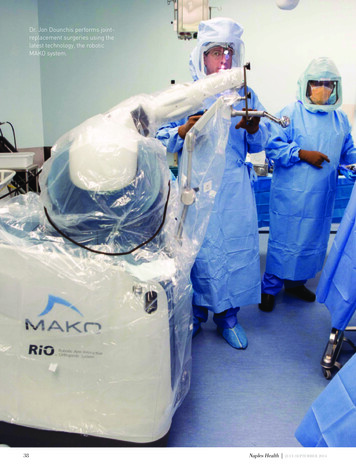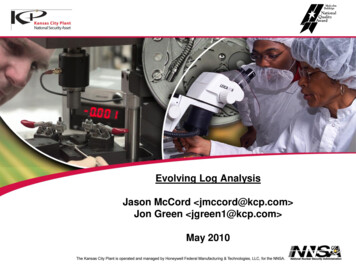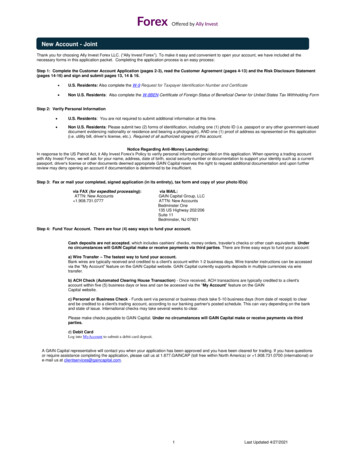
Transcription
Dr. Jon Dounchis performs jointreplacement surgeries using thelatest technology, the roboticMAKO system.38Naples Health JULY-SEPTEMBER 2014
YourAching JointsWill Love ThisTHE MAKO ROBOT ENABLES HIP- AND KNEE-REPLACEMENTSURGERY TO BE MORE PRECISE AND LESS INVASIVE.PHOTOGRAPHS BY ERIK KELLAROrthopedic surgeon Dr. Jon Dounchis peers atan image of a patient’s hip one morning in theoperating suite at NCH’s Downtown NaplesHospital using the state-of-the-art MAKORobotic Arm Interactive Orthopedic system,which produces the 3-D model Dr. Dounchisis studying before his patient is wheeled into surgery. It is acomputerized model, three-dimensional, and marked with twoJULY-SEPTEMBER 2014 Naples Healthcolorful dots: a magenta one showing where her hip currentlysat, and a lime green one a little farther back showing wherethe surgeon would place a new ceramic ball and a cross-linkedpolymer and titanium socket, replacing her worn-out and outof-place joint.Dr. Dounchis is well-experienced with the robotic systemand says the change from manual to robot-guided surgery hasbeen tremendous. The system gives him more data about eachpatient’s anatomy and allows him to preplan the operationrather than decide in the moment what size implants a patientneeds and where exactly they ought to be placed. About 2,000people have joint replacement surgery each year at NCH,which has the latest, most up-to-date robotic system.39
LOCALLY OWNED & OPERATEDOne to 24 hoursNo MinimumsNo extra fees for Nightsand WeekendsPersonalized Care After SurgeryBathing and DressingMedication ManagementHome Cooked MealsTransportationDog Walkingso happy to“ Ibeama daughteragain.Thank youfor caring for mymom, the wayI do.“-Satisfied JLFCustomer inNaples, FL(239) 431-6661jlfhc.com License# 30211271LET US TAKE YOU THERE!Airport ServicesNon-emergencyTransport ServicesGroup TransportationSpecial OccasionsPersonal AppointmentsOne Way or Round-Trip Transportation.No Minimums. Stand-by Rate & Package PlansAvailable. Handicap accessible. Trained,licensed, insured safe and friendly drivers!(239) 682-8907SAFETY. FREEDOM. INDEPENDENCEONE PHONE CALL AWAY.40THE COMPUTER ACTS AS AHIGH-TECH SET OF “EYES” TOGUIDE DOCTORS THROUGHSMALL-AS-POSSIBLE INCISIONS.Right now, patients can have partial knee replacements and total hipreplacements using the MAKOplastyprocedure. Private insurance companiesand Medicare cover the surgery, andpatients’ costs aren’t higher than theyare for traditional joint replacementtechniques, according to Dr. Dounchis.NCH owns one of 30 MAKO devices inFlorida.Using the robotic system helps surgeonsperform minimally invasive surgeries.The computer acts as a high-tech set of“eyes” to guide doctors through smallas-possible incisions.Here’s how a “MAKOplasty” works: Surgeons load a CT scan of a patient’s kneeor hip into the MAKO system, whichthen produces a 3-D image of a patient’sknee or hip. With that model, the surgeon can then digitally manipulate thejoint, experimenting with different-sizecomponents or tweaking the placementof those devices before he makes anincision. Then, the surgeon employs arobotic arm to polish rough bone surfaces and place the implants precisely.Tom Martin of Tampa stumbled onto theMAKOplasty procedure while researching his options for his deteriorating hips.He’d known others who’d had their hipsreplaced and worried about the movement restrictions they suffered.“I do know people who had (surgery) ayear, year and a half ago and they stillcan’t put socks on and they still walkwith a limp,” he says. A former professional football player, Martin enjoysracquetball and golf in addition torunning his mortgage brokerage firm. Heput aside his racket about a year beforesurgery because of his worsening joints.Martin called Dr. Dounchis, and the surgeon explained that the robotic deviceNaples Health JULY-SEPTEMBER 2014
helped him to avoid cutting tendons.Martin decided to travel to NCH for thesurgery. He had one hip replaced on aMonday, the second on that Thursdayand was out of the hospital that Saturdaymorning.“I walked a staircase on Friday witha rehab therapist,” Martin says. “Oneweek after surgery, I no longer had acane or a walker.”Within a month, Martin says, he hadwalked a golf tournament, a St. Patrick’sDay parade and an air show, and wasabout to hit the racquetball court againto start reconditioning.Exceptional Care Personalized ServiceRonald L. Levine, M.D., M.S.BOARD CERTIFIED CARDIOLOGIST2014 Pascotto Golden HeartAward Recipientfor commitment to improving hearthealth in Southwest FloridaMedicare and Most Insurances Accepted Privileges at NCH680 2nd Avenue North, Suite 304, NaplesConvenient Parking just outside our doorwww.levineheart.com42“We limit what we burr (shave) so itfits precisely,” Dr. Dounchis explains.The whole procedure is data-driven; ifa surgeon were to try to take off morebone than the calculations called for,the robot would shut down. Likewise,the system informs a surgeon if he orshe strays from the computer-assistedplacement plan developed prior to theprocedure. That’s important. Some400,000 hip and knee replacements areperformed in the United States annually,according to the American Academy ofOrthopaedic Surgeons, but about 10 percent of joints must be redone for variousreasons, including improper placement.In contrast, a study highlighted on thedevice-maker’s website showed only a1.1 percent revision surgery rate for hipstwo years after implant by MAKOplasty.“Manually, it’s very technically demanding to be able to balance the componentsand the gap of articulation between thecomponents,” Doug Varga of Stryker,the company that produces the Makoplasty, says. Everything has to fit justright, down to the millimeter, for the newjoint to slide properly, like one’s naturaljoint did before age, injury, arthritisor a related situation made movementpainful.“We are knocking down any guessworkinter-operatively as well as improvingpatient function immediately post-op,”Varga says. Statistics suggest patientsexperience less pain after a MAKOplasty because the components are moreNaples Health JULY-SEPTEMBER 2014
precisely placed.“It’s just awesome,” Dr. Dounchis says, digitally maneuveringthe implant that he would actually place later that day. “I canput this cup wherever I want to.”How to prepare for jointreplacement surgerySo what can you as a patient do to help your joint replacementsurgery go even more smoothly? How fast you recover dependson a lot of things, but some of those factors—your overallstrength, health, mental preparedness—are entirely withinyour control.Suzanne Graziano, nursing director for 5 South Orthopedicsand the Brookdale Center for Healthy Aging & Rehabilitation,leads pre-operative patient education classes designed to easethe recovery period and take the fear out of joint replacementsurgery. Here are some of the strategies she shares:1. Keep moving. If possible, maintain whatever fitnessregimen your doctor or physical therapist has recommended. Ifyour mobility is limited, you can still keep the muscles activeby doing eight to 10 reps of the following exercises throughoutthe day:44 Squeeze your glutes: Activate those all-important musclesby squeezing, holding for a few counts, releasing andrepeating the process. Activate your quads: Tighten your quads by straighteningthe leg and squeezing the muscle right above the knee.Hold and repeat. Point and flex: That simple up-and-down foot movementactivates the lower leg and knee.2. Hydrate. Drink an 8-ounce glass of water eight to 10times a day.3. Fuel your body. Surgery—even today’s noninvasive versions—is tough. Increase your intake of fruits and vegetablesso that your body is healthy going into the operation.4. Prepare your home. Modify as needed to account forlimited mobility immediately after surgery. Make sure youhave a strong support system in place for the weeks followingsurgery.5. Know what to expect. In the hospital, your care teamwill be getting you up and out of bed as soon as possible toavoid post-surgical complications such as clotting. “Movementhelps with pain, with circulation, with digestion,” Grazianosays. “Movement is key.” Once you are out of the hospital,you’ll see a physical therapist in your home twice a week forNaples Health JULY-SEPTEMBER 2014
“MOVEMENT HELPSWITH PAIN, WITHCIRCULATION, WITHDIGESTION. MOVEMENTIS KEY.”one to three weeks (depending on patient needs) and thenbegin outpatient rehabilitation.6. Manage your pain. Your doctor will prescribe medication, as needed, to help with acute post-surgical pain. Youshould also plan to use ice and follow your physical therapist’sexercise plan. Balance that with plenty of rest—your body willneed it.7. Slow down! At least for a little while. “Be patient withyourself as you are healing,” Graziano advises.For information on the Preoperative Patient Education Program for Total Joint Replacements, call 624-3917. Classesare held weekly at the Downtown Naples and North NaplesHospitals.CALL: 239-592-51129140 Galleria Court , Naples, FL 34109GALLERIA DENTISTRYDr. Gery P. Benza Dr. George V. Dumouchel Cosmetic & Restorative DentistryRestoration of Dental ImplantsCerec Crowns in one appointmentDigital X-raysNitrous OxidePersonal attention in a relaxed atmospherePleasant staff that delivers the highestquality care.Proud to be serving Naples for over 30 years!www.GalleriaDentistry.comc oicwhinneer. We love to create beautiful smiles!JULY-SEPTEMBER 2014 Naples Health45
Martin decided to travel to NCH for the surgery. He had one hip replaced on a Monday, the second on that Thursday and was out of the hospital that Saturday morning. “I walked a staircase on Friday with a rehab therapist,” Martin says. “One week after surgery, I no longer had











